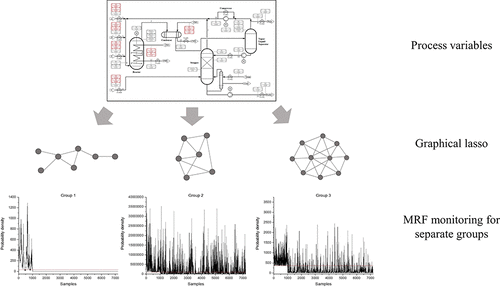当前位置:
X-MOL 学术
›
Ind. Eng. Chem. Res.
›
论文详情
Our official English website, www.x-mol.net, welcomes your feedback! (Note: you will need to create a separate account there.)
Efficient Process Monitoring via the Integrated Use of Markov Random Fields Learning and the Graphical Lasso
Industrial & Engineering Chemistry Research ( IF 4.2 ) Pub Date : 2018-09-18 , DOI: 10.1021/acs.iecr.8b02106 Changsoo Kim 1 , Hodong Lee 1 , Kyeongsu Kim 1 , Younggeun Lee 1 , Won Bo Lee 1
Industrial & Engineering Chemistry Research ( IF 4.2 ) Pub Date : 2018-09-18 , DOI: 10.1021/acs.iecr.8b02106 Changsoo Kim 1 , Hodong Lee 1 , Kyeongsu Kim 1 , Younggeun Lee 1 , Won Bo Lee 1
Affiliation

|
Process monitoring is an important aspect of safe operation of process plants. Various methods exist that monitor the process using data-driven methods, but they all have certain limitations. For instance, most of the fault detection methods are not able to detect the fault propagation path, and some methods require a priori knowledge on the faults, or the relationships between the monitored variables. In this study, a monitoring method for accurately detecting the faults and analyzing the fault propagation path is proposed. Named the Glasso-MRF monitoring framework, this method integrates the use of the graphical lasso algorithm (G-lasso) and the Markov random field (MRF) modeling framework to divide the monitored variables into relevant groups and then detect the faults separately for each of the groups. Graphical lasso uses the lasso constraint on the inverse covariance matrix of variables within the maximum likelihood estimation problem, driving it to be of sparse form. The use of graphical lasso downsizes the process into groups that are highly correlated, relieving the computational complexity of the MRF-based monitoring so that the process can be efficiently monitored, and enabling the fault propagation path to be identified. MRF modeling can extensively model the variable relationships including cyclic structures, and can be obtained without a priori knowledge of the relationships between variables, using the iterative graphical lasso algorithm proposed in this study. The inference of MRFs are usually complex due to the existence of partition functions, but by down-sizing the system using iterative G-lasso, this problem is resolved as well. The proposed method was applied to the well-known Tennessee Eastman process to evaluate its performance. The detection accuracy of the Glasso-MRF monitoring framework was higher than any other state-of-the-art monitoring methods, including autoencoders and Bayesian networks, showing more than 95% fault detection accuracy for all of the 28 faults programmed within the Tennessee Eastman process. Also, the fault propagation path could be detected according to the difference in fault detection time of the divided groups, providing enhanced analysis of the initiated fault. These results prove that the proposed methodology can effectively detect the fault as well as show its propagation throughout the process, without any a priori knowledge of the process variables.
中文翻译:

通过集成使用马尔可夫随机场学习和图形套索进行有效的过程监控
过程监控是过程工厂安全运行的重要方面。存在使用数据驱动的方法监视过程的各种方法,但是它们都有一定的局限性。例如,大多数故障检测方法不能检测故障传播路径,并且某些方法需要对故障或所监视变量之间的关系有先验知识。提出了一种准确检测故障并分析故障传播路径的监测方法。该方法名为Glasso-MRF监视框架,该方法集成了图形套索算法(G-lasso)和马尔可夫随机域(MRF)建模框架的使用,可将监视的变量分为相关的组,然后针对每个变量分别检测故障组。图形套索在最大似然估计问题内对变量的逆协方差矩阵使用套索约束,从而使其成为稀疏形式。图形套索的使用将过程缩小为高度相关的组,从而减轻了基于MRF的监视的计算复杂性,因此可以有效地监视过程,并能够确定故障传播路径。MRF建模可以广泛地建模包括循环结构在内的变量关系,并且可以使用本研究中提出的迭代图形套索算法在无需先验变量之间关系的情况下获得模型。由于存在分区功能,MRF的推论通常很复杂,但是通过使用迭代G-套索缩小系统的尺寸,这个问题也得以解决。将该方法应用于著名的田纳西·伊士曼(Tennessee Eastman)过程,以评估其性能。Glasso-MRF监视框架的检测精度高于任何其他最新的监视方法,包括自动编码器和贝叶斯网络,在田纳西州伊士曼市内编程的所有28个故障中,其故障检测精度均超过95%过程。而且,可以根据划分的组的故障检测时间的差异来检测故障传播路径,从而增强了对启动故障的分析能力。这些结果证明,所提出的方法可以有效地检测故障并显示其在整个过程中的传播,而无需任何过程变量的先验知识。
更新日期:2018-09-18
中文翻译:

通过集成使用马尔可夫随机场学习和图形套索进行有效的过程监控
过程监控是过程工厂安全运行的重要方面。存在使用数据驱动的方法监视过程的各种方法,但是它们都有一定的局限性。例如,大多数故障检测方法不能检测故障传播路径,并且某些方法需要对故障或所监视变量之间的关系有先验知识。提出了一种准确检测故障并分析故障传播路径的监测方法。该方法名为Glasso-MRF监视框架,该方法集成了图形套索算法(G-lasso)和马尔可夫随机域(MRF)建模框架的使用,可将监视的变量分为相关的组,然后针对每个变量分别检测故障组。图形套索在最大似然估计问题内对变量的逆协方差矩阵使用套索约束,从而使其成为稀疏形式。图形套索的使用将过程缩小为高度相关的组,从而减轻了基于MRF的监视的计算复杂性,因此可以有效地监视过程,并能够确定故障传播路径。MRF建模可以广泛地建模包括循环结构在内的变量关系,并且可以使用本研究中提出的迭代图形套索算法在无需先验变量之间关系的情况下获得模型。由于存在分区功能,MRF的推论通常很复杂,但是通过使用迭代G-套索缩小系统的尺寸,这个问题也得以解决。将该方法应用于著名的田纳西·伊士曼(Tennessee Eastman)过程,以评估其性能。Glasso-MRF监视框架的检测精度高于任何其他最新的监视方法,包括自动编码器和贝叶斯网络,在田纳西州伊士曼市内编程的所有28个故障中,其故障检测精度均超过95%过程。而且,可以根据划分的组的故障检测时间的差异来检测故障传播路径,从而增强了对启动故障的分析能力。这些结果证明,所提出的方法可以有效地检测故障并显示其在整个过程中的传播,而无需任何过程变量的先验知识。



























 京公网安备 11010802027423号
京公网安备 11010802027423号